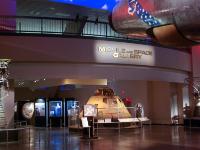Cold War Gallery South
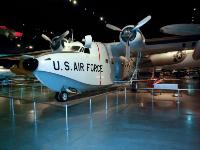 1 Entering the southern hangar of the Cold War Gallery, we are welcomed by the major players in the most insane period in the planet's history. |
 2 DEFCON: The U.S. Armed Forces measure their readiness during military situations by Defense Readiness Condition (DEFCON). Based upon the severity of a crisis, this readiness ranges from DEFCON 5, the normal peacetime level, to DEFCON 1 when an enemy attack is expected. Throughout the Cold War, people and governments feared going to DEFCON 1 because it meant nuclear war but that level was never reached. |
 3 Responding to the U.S. Army Air Forces' requirement for a strategic bomber with intercontinental range, Consolidated Vultee (later Convair) designed the B-36 during World War II. The aircraft made its maiden flight in August 1946, and in June 1948 the Strategic Air Command received its first operational B-36. |
 4 World War II proved what the proponents of air power had been championing for the previous two decades — the great value of strategic forces in bombing an enemy's industrial complex and of tactical forces in controlling the skies above a battlefield. As a result, the Strategic and Tactical Air Commands were created on March 21 1946, establishing the offensive composition of the USAF that existed for more than 40 years. |
 5 Some B-36s served as photographic reconnaissance aircraft and others were adapted to launch and retrieve specially modified RF-84F/K THUNDERFLASH reconnaissance planes. An exmaple of the RF-84 is on display at the rear of the B-36. |
 6 The B-36 was powered by six Pratt & Whitney R-4360 engines and the B-36J cruised at 230 mph. For additional bursts of speed its four General Electric J47s increased the maximum speed to 435 mph. It carried 86,000 pounds of nuclear or conventional bombs. |
 7 When the XB-36 was designed during World War II, specifications called for two main landing gear wheels equipped with the largest aircraft tyres produced in the U.S. Because of the enormous pressures imposed by the XB-36 on concrete runways when equipped with single wheels, it could take off and land safely at very few airfields. As a result, production B-36s incorporated four smaller wheels and tires on each of its main landing gears. |
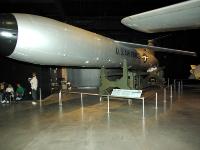 8 In the foerground is the BOSTON CAMERA. This camera, manufactured for the USAF by Boston University in 1951, is the largest aerial camera ever built. The camera made an 18-by-36-inch negative and was so powerful that a photo interpreter could detect a golf ball from an altitude of 45,000 feet. |
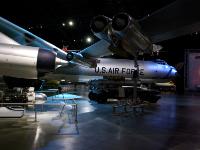 9 When production ended in August 1954, more than 380 B-36s had been built. In 1958-1959, the USAF replaced the B-36 with the all-jet BOEING B-52. Although never used in combat, the B-36 was a major deterrent. The aircraft on display made the last B-36 flight ever and flew to the museum from Davis-Monthan AFB, Arizona on April 30, 1959. |
 10 McDONNELL XF-85 GOBLIN was a "parasite" fighter developed to protect B-36 bombers flying beyond the range of conventional escort fighters. Planners envisioned a "parent" B-36 carrying the XF-85 in the bomb bay and, if attacked, the Goblin would be released to combat the attackers. Later, the Goblin would return to the B-36. Test aircraft were launched and retrieved several times from an EB-29B, but none ever flew from a B-36. This unusual program ended in late 1949 when aerial refueling of conventional fighter aircraft showed greater promise. |
 11 The CONVAIR B-58A HUSTLER was the USAF's first operational supersonic bomberand it made its initial flight on Nov. 11 1956. Distinctive features included an inertial guidance navigation and bombing system, a slender "wasp-waist" fuselage and an extensive use of heat-resistant honeycomb sandwich skin panels in the wings and fuselage |
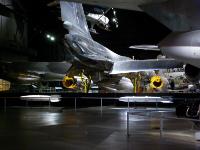 12 Because the thin fuselage prevented the carrying of bombs internally, a droppable, two-component pod beneath the fuselage contained a nuclear weapon — along with extra fuel, reconnaissance equipment or other specialized gear. The B-58 crew consisted of a pilot, navigator/bombardier and defense systems operator. |
 13 Convair built 116 B-58s: 30 test and pre-production aircraft and 86 for operational service that flew in the Strategic Air Command between 1960 and 1970. The B-58 set 19 world speed and altitude records and won five different aviation trophies. |
 14 Bailing out at speeds above 665 MPH was "extremely hazardous". Who ever would have thought it? |
 15 The B-58A on display set three speed records while flying from Los Angeles to New York and back on March 5, 1962. For this effort, the crew received the Bendix and Mackay Trophies for 1962. It was flown to the museum in December 1969. |
 16 The NORTH AMERICAN F-86H SABRE was perfected after the signing of the Korean Armistice and it never flew in combat. The F86-H incorporated the knowledge gained from the thousands of combat missions flown by the earlier variants. It was primarily a fighter-bomber and although the F-86H was larger and heavier than its predecessors, it had better all-around performance. |
 17 The museum obtained the F-86H on display from the New Jersey Air National Guard in November 1964. It is exhibited with part of its stressed skin removed to show the internal structure and placement of equipment. You can see where the fuselage splits in two to get at the engine |
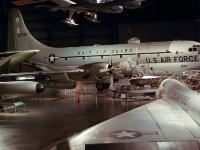 18 The BOEING KC-97 STRATOFREIGHTER was a cargo version of the B-29 WWII bomber. The C-97 Stratofreighter first flew in November 1944 and the tanker version, the KC-97L with the "flying boom" refueling system, in 1950. In all, the USAF ordered 890 aircraft: 74 C-97s and 816 KC-97s. |
 19 In 1964 some KC-97Ls received two jet engines. The increased speed of these KC-97L aircraft made them more compatible with high performance jet aircraft and they served primarily with the Air National Guard. The USAF retired its last C/KC-97 in 1973, but others remained in use with the Air Force Reserve and Air National Guard as tankers or search and rescue aircraft. |
 20 During Operation Creek Party in Germany, which started in 1967 and lasted for 10 years, these tankers supported active duty USAF and NATO units in Europe. The aircraft on display participated in this operation and, on June 7 1973, the mayor of Zeppelinheim, a town near Rhein-Main Air Base in West Germany, christened this aircraft in his town's honor. The Zeppelinheim was flown to the museum in August 1976. |
 21 The aircraft in front is CESSNA U-3A which is the military version of the Cessna 310 twin-engine and was used as for light administrative liaison, cargo and utility transport. Behind it is the De HAVILLAND U-6A BEAVER. De Havilland Aircraft of Canada manufactured the U-6A and delivered nearly 1,000 to the US armed services. |
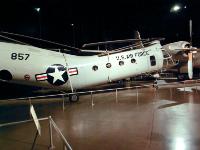 22 The VERTOL CH-21B WORKHORSE was designed by helicopter pioneer Frank Piasecki and it first flew in April 1952. With two main rotors, its long fuselage could hold large numbers of people or heavy cargo loads. The H-21 could carry either 20 fully-equipped troops or 12 litter patients and two medical attendants. |
 23 The H-21 served with the USAF, the US Army, the French navy, the Royal Canadian Air Force and the West German Air Force. The museum obtained the CH-21B on display from Eglin Air Force Base, Florida in January 1965. |
 24 The BOEING B-50D SUPERFORTRESS was the last propeller-driven bomber delivered to the USAF and it made its initial flight on June 25, 1947. It was basically an improved version of the B-29 WWI bomber but the aircraft's large number of modifications caused it to be re-designated as the B-50. |
 25 Between 1948 and 1954, B-50s served with the Strategic Air Command as medium bombers until they were replaced by jet-propelled B-47s. Many were modified for support roles such as weather reconnaissance, crew training, photo-mapping and aerial refueling. It was powered by the magnificent 4 row, 28 cyclinder PRATT & WHITNEY R-4360. |
 26 In 1963 the USAF started phasing out the WB-50Ds, and in 1965 the aircraft on display became the last WB-50D to be retired. It was delivered to the museum in 1968. |
 27 |
 28 Through out the late 1950s, the USAF replaced its F-84Fs with supersonic F-100s and the Thunderstreaks went to Air National Guard units. However, some F-84Fs temporarily returned to USAF service in the early 1960s due to the Berlin crisis. |
 29 The aircraft on display was flown to the museum in 1970 following its assignment to the Ohio Air National Guard. During its career, it served in England, Greece, Alaska and the continental United States. In 1961 it participated in the mass deployment of 200 fighters across the Atlantic Ocean to Europe in response to the Berlin situation. |
 30 The two-place LOCKHEED T-33A SHOOTING STAR was designed for training pilots already qualified to fly propeller-driven aircraft. It was developed from the single-seat F-80 fighter by lengthening the fuselage about three feet to accommodate a second cockpit. |
 31 The T-33 is one of the world's best-known aircraft, having served with the air forces of more than 20 different nations over several decades. The T-33A on display was flown to the museum in 1962. |
 32 The Columbia Aircraft Corp built the GRUMMAN OA-12 DUCK J2F-6 Duck on display. It was delivered to the US Coast Guard on June 9 1945 and it became surplus in 1946. Afterward it had a series of civilian owners and "starred" in several films, including "Murphy's War" of the early 1970s. This aircraft is painted to represent one of the rescue OA-12s the USAF acquired in 1948. |
 33 GRUMMAN designed the HU-16B ALBATROSS to meet a US Navy requirement for an amphibious utility aircraft that could use skis to operate from snow and ice. During the Korean War Albatrosses rescued almost 1,000 UN personnel from coastal waters and rivers, often behind enemy lines. They also made numerous rescues in SE Asia on occasion taxiing many miles over rough, open water when unable to take off. |
 34 The prototype first flew on Oct. 24 1947, and soon after the USAF ordered a quantity for air-sea rescue duties as SA-16As. Grumman delivered 297 HU-16s to the Air Force, mostly for the Air Rescue Service. |
 35 The HU-16 on display was one of the last operational USAF Albatrosses. It established a world altitude record for twin-engine amphibians when it reached 32,883 feet on July 4 1973. Two weeks later, it was flown to the museum. |
 36 LOCKHEED F-4G STARFIGHTER. The USAF procured about 300 Starfighters in one and two-seat versions. More than 1,700 F-104s were built in the United States and abroad under a military aid program for various nations including Canada, West Germany, Italy, Norway, the Netherlands, Belgium, Denmark, Greece, Turkey, Spain, Taiwan and Japan. |
 37 The aircraft on display served with the USAF in California, West Germany, Spain, Taiwan, Vietnam and Thailand. It also was flown by the winning pilot of the 1962 USAF "William Tell" Fighter Weapons Meet competition. It was flown to the museum in August 1975. |
 38 CESSNA LC-126. Needing a rugged aircraft for Arctic rescue service, the USAF acquired 15 LC-126s in 1949. Each LC-126 came equipped with an interchangeable set of floats and skis to permit operation from land, snow or water. The LC-126A on display is marked as it appeared while serving at Elmendorf Air Force Base, Alaska in 1949. |
 39 The REPULIC RF-84K THUNDERFLASH he RF-84K was a reconnaissance and nuclear strike fighter that was intended to be carried toward a target as a "parasite" underneath the B-36 bomber. At the time, jet aircraft possessed relatively short range and aerial refueling was not yet proven, so this provided a method to extend their range. |
 40 See the hook in front of the pilot? The mission profile called for the recon aircraft or attack fighter to leave the carrier aircraft and, upon reaching hostile territory, make a dash to the target and perform its mission. The aircraft then returned to the waiting carrier, hooked up underneath it and was carried back to a base. |
 41 The RF-84K entered service in 1955. For the next year, pilots experienced many near disasters while separating or hooking back up to the GRB-36 carrier aircraft. By 1957, the development of more capable strategic reconnaissance aircraft, along with greater range provided by dependable aerial refueling, made the parasite aircraft concept obsolete. |
 42 The RF-84Ks were transferred to other units flying and thereafter flew conventional missions from runways. The museum's aircraft is marked as it appeared while serving in the 91st Strategic Reconnaissance Squadran in the mid-1950s. |
 43 NORTH AMERICAN F-86D SABRE. An intelligence warning in 1948 prompted the USAF to develop an all-weather interceptor. Starting with the basic airframe of an F-86A, North American incorporated a highly sophisticated electronic system to replace the second crewmember carried by other interceptors of the time. Also, the F-86D became the first production single-seat fighter where air-to-air missiles replaced the classic gun armament |
 44 The F-86Ds air intake was reshaped to make room for the enclosed radar. The radar and associated fire-control computed the target's position, guided the aircraft on an intercept course to within 500 yards of the target, lowered the retractable tray of 24 rockets, and fired the rockets automatically. |
 45 North American delivered 2,506 F-86Ds before production ended in September 1953. Although the USAF had phased out its F-86D by June 1961, Japan and other nations continued flying them. The aircraft on display came to the museum in August 1957. It is marked as an F-86D assigned to the 97th Fighter Interceptor Squadron at Wright-Patterson AFB, Ohio, during the mid-1950s. |
 46 The AVRO CF-100 Mk.4A CANUCK was the only Canadian-designed and Canadian-built fighter to go into large-scale production. It was powered by two Canadian-designed Orenda jet engines and entered service in 1953. In 1957 the two-seat CF-100 became an integral part of the newly formed U.S.-Canadian North American Air Defense (NORAD) system. |
 47 The LOCKHEED F-94A STARFIRE all-weather interceptors were developed from the Lockheed P-80 Shooting Star. The prototype F-94 first flew on July 1, 1949. Twenty-four rockets were carried in the nose in a ring around the radome, shielded by retractable doors, with an additional 24 in the wing pods, if installed. |
 48 The F-94C carried no guns. Starfires were employed in the air defense of the continental United States in the 1950s. In the F-94A form, they served as the first all-jet, all-weather interceptor for the Air Defense Command. The last F-94Cs were withdrawn from USAF service in 1959. |
 49 The aircraft on display has been painted to represent an F-94C assigned to the 60th Fighter Interceptor Squadron at Otis Air Force Base, Mass. during the late 1950s. |
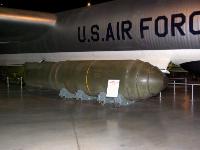 50 The MARK 17 THERMONUCLEAR BOMB The MK-17 was the first operational USAF thermonuclear "H-Bomb". The "H" refers to the hydrogen which was fused under intense heat conditions to produce unprecedented energy yields. The MK-17 was carried by B-36s and was in service from 1954 until 1957. By today's standards, it was extremely large and heavy. It had a casing 3 1/2 inches thick, a length of 24 feet 10 inches, diameter of 5 feet 2 inches and a loaded weight of 41,400 pounds. Isn't progress wonderful? |
 51 The MARK VI NUCLEAR BOMB was developed in 1949 and was basically an improved? version of the "Fat Man" bomb that was dropped on Nagasaki, Japan in 1945. It was the USAF's first mass produced nuclear weapon. The last Mark VI was retired in 1962. |
 52 The MARK 41 THERMONUCLEAR BOMB was first produced in 1960 and is no longer in service. It was intended to be released at high-altitude, using parachutes to retard its fall, thereby permitting the releasing plane to escape from the target area safely. |
 53 Isn't this clever? You can tailor your needs to suit the delivery method and the target. |
 54 The MARTIN CGM-13B MACE was a tactical surface-launched missile designed to destroy ground targets.The Mace could be launched from either a mobile trailer or a bomb-proof shelter. A booster rocket launched the Mace and a jet engine propelled it to the target. It could carry a conventional or nuclear warhead. |
 55 The MARTIN TM-61A MATADOR was the USAF's first pilotless bomber. The Matador used a concept similar to the German V-1 "buzz bomb" of World War II except that the Matador was controlled electronically from the ground during flight. It was launched from a mobile 40-foot trailer by a booster rocket that fell away and then continued toward its target powered by a jet engine. |
 56 The NORTHROP SM-62 SNARK was a pilotless nuclear missile that represented an important step in weapons technology during the Cold War. The SM-62 (Strategic Missile) program lasted from 1945-1961, and it gave the USAF valuable experience in developing long-range strategic nuclear missile systems. The SM-62 was a forerunner of the cruise missiles developed many years later. |
 57 I now leave the Cold War Gallery and enter the Missile and Space Gallery. Because of their height, the missiles are ehibited in a silo instead of a hangar. END OF TOUR. THE STORY CONTINUES IN MISSILE AND SPACE GALLERY Next Folder: Missile and Space Gallery |
